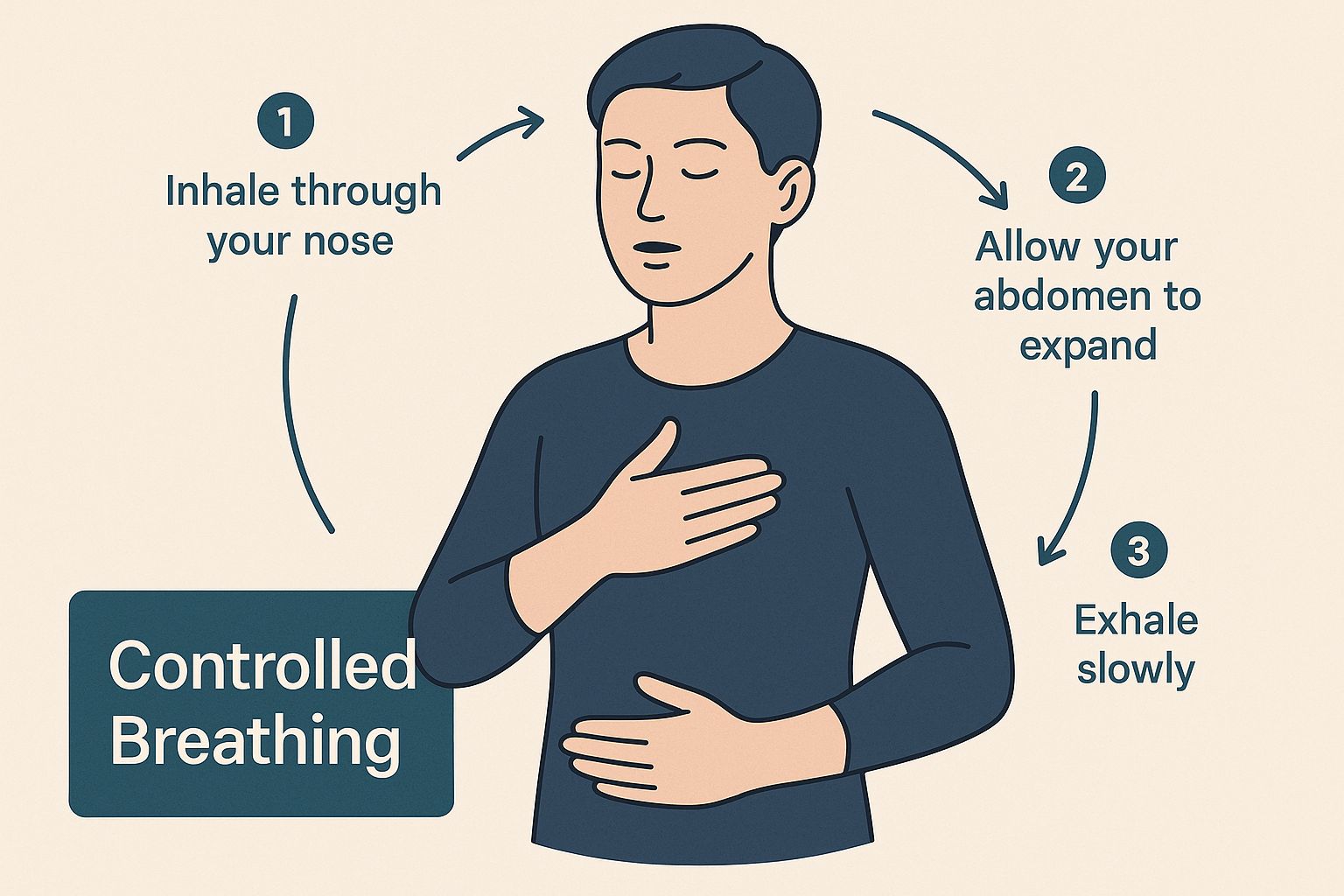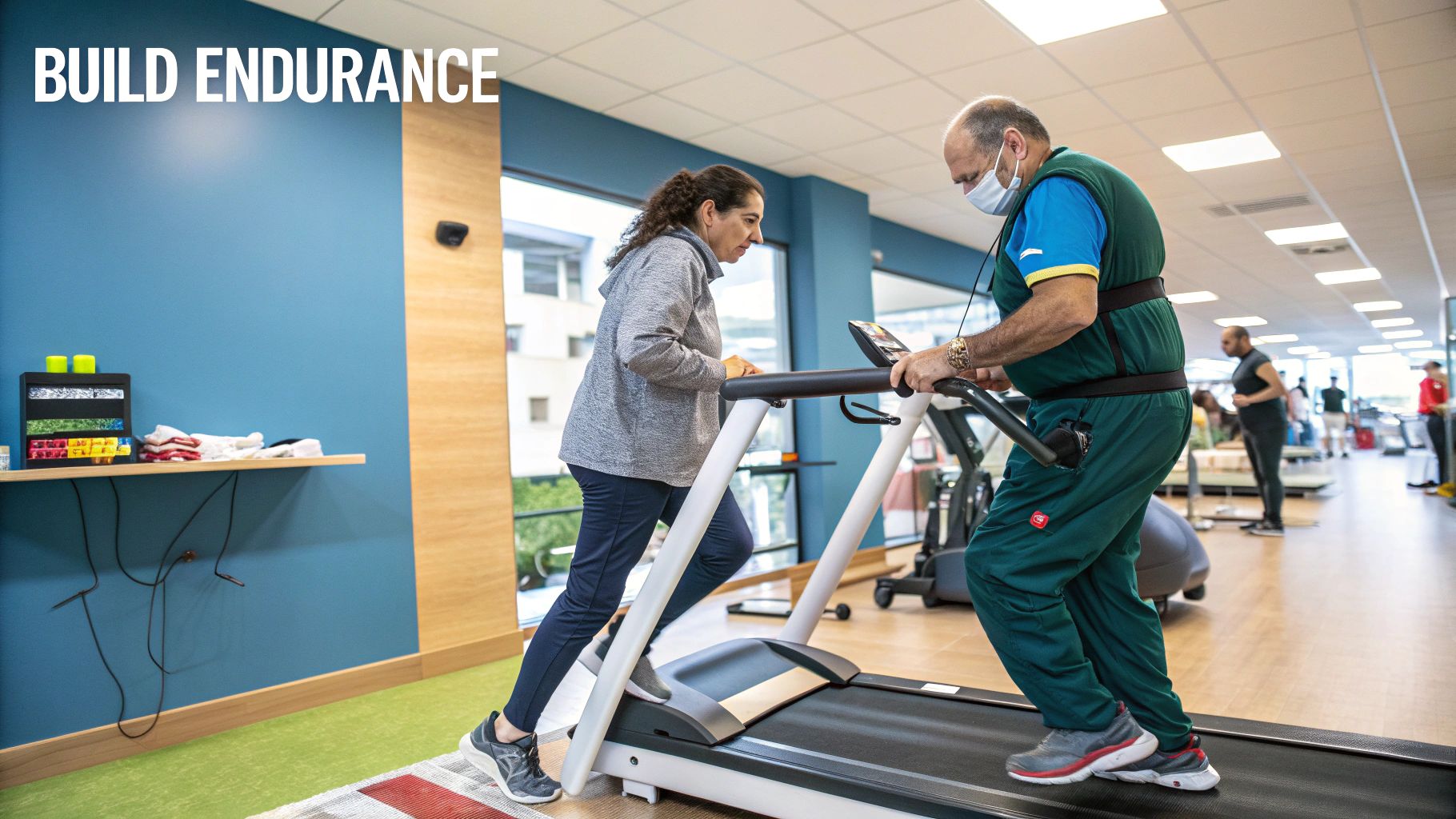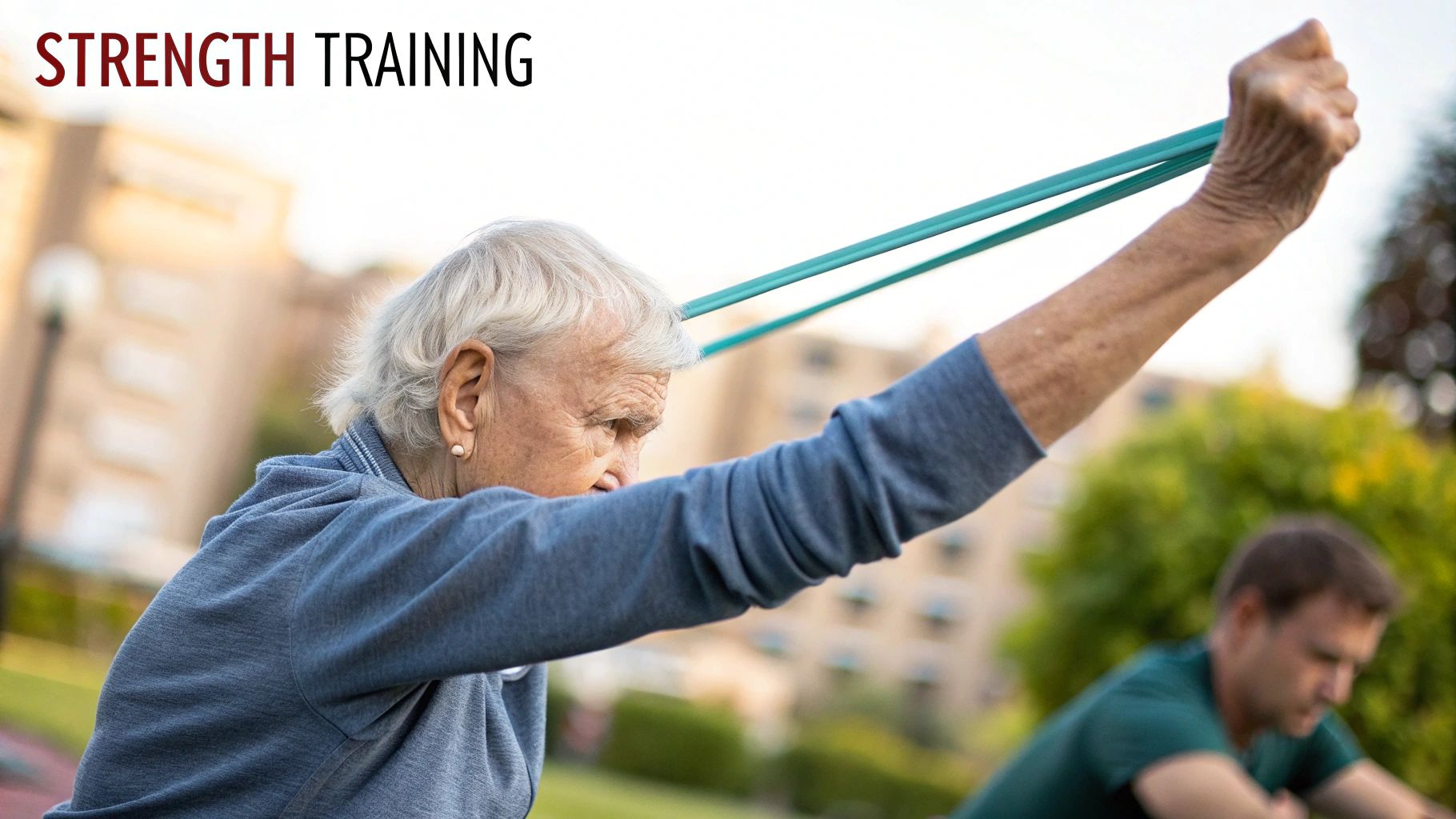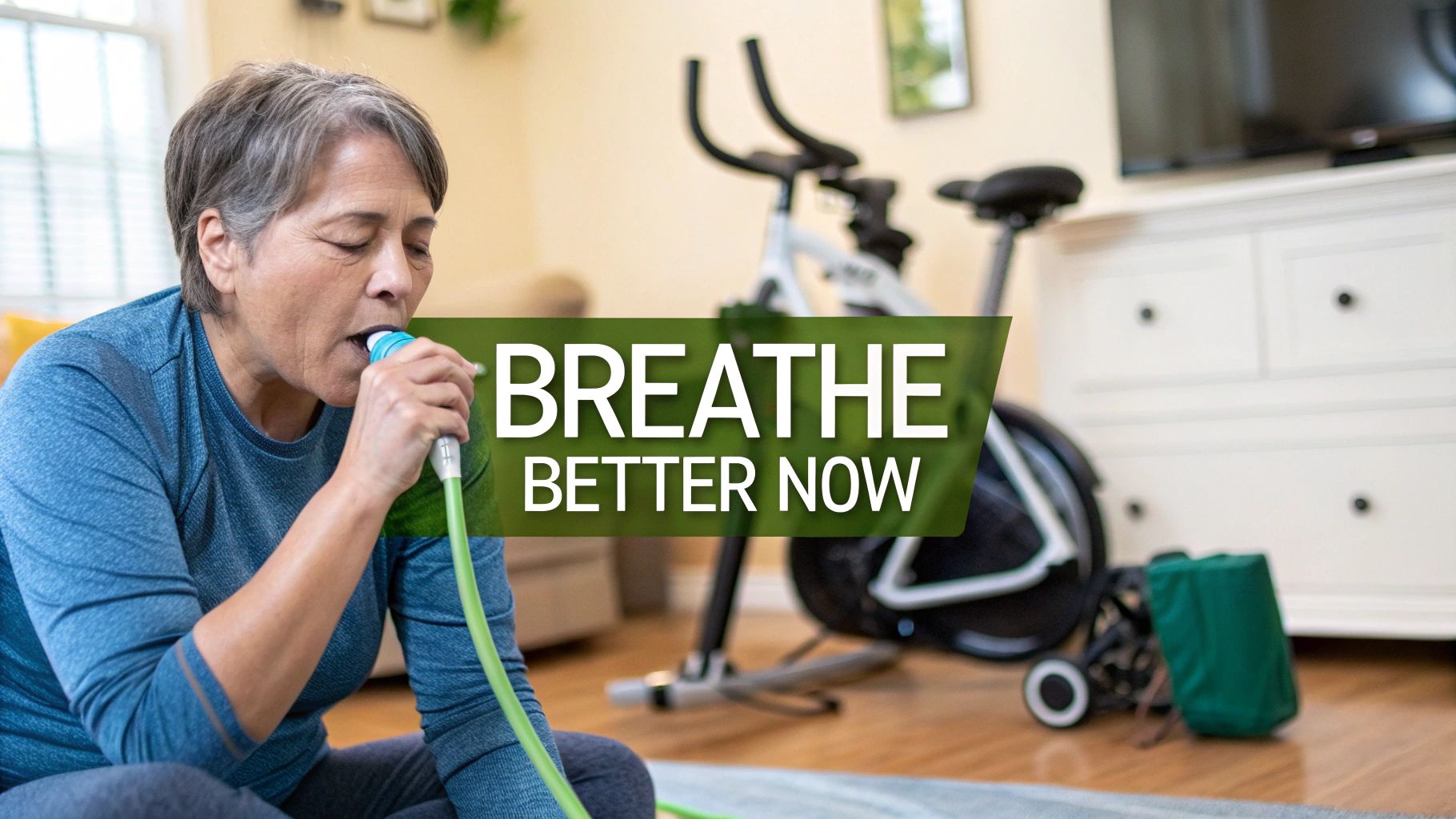.webp)
Pulmonary rehab isn't just a set of clinical exercises; it's a structured, medically supervised programme designed to improve how your lungs work, cut down on breathlessness, and genuinely enhance your day-to-day life if you're living with a chronic respiratory condition. Think of it as a specialised combination of targeted physical training and smart breathing techniques, all designed to build your strength and stamina safely.
Let's look past the clinical terms for a moment. At its heart, pulmonary rehabilitation is about getting back the parts of your life that breathlessness has chipped away at. It’s far less about hitting targets on a treadmill and much more about having the energy to walk to the local shops, the stamina to play with your grandchildren in the park, or even just getting through daily chores without feeling completely wiped out and anxious.
Living with a chronic lung condition can often feel isolating. A good rehab programme gives you a clear, supportive pathway back to feeling confident and in control of your body.
The whole process usually kicks off with a referral from your GP or a respiratory specialist. From there, you'll have an initial assessment with a team of healthcare professionals—often including physiotherapists and specialist nurses—who will get a clear picture of your current fitness, your breathing capacity, and what you personally want to achieve. This isn't a one-size-fits-all plan; it's built entirely around you.
Once you get started, the focus is all on making steady, safe progress. The exercises are designed to strengthen your entire body, not just your lungs. Why? Because when your muscles are stronger and more efficient, they don't demand as much oxygen to do their job. This takes a huge amount of strain off your respiratory system. It's why a typical session will mix gentle aerobic exercise with a bit of light strength training.
The real goal here is to break a debilitating cycle. When you feel short of breath, your natural instinct is to avoid activity. But inactivity leads to weaker muscles, which then makes you feel even more breathless when you next try to do something. Pulmonary rehab helps you safely reverse that downward spiral.
The educational side of things is just as important. You'll learn powerful breathing techniques to manage breathlessness when it strikes, find out how to use your inhalers for maximum effect, and pick up practical strategies for conserving your energy throughout the day. This knowledge is empowering. It helps you understand and proactively manage your condition. Many of our patients find that receiving expert guidance on respiratory medicine helps them feel more in control than they have in years.
Before we go on, let's break down how the clinical goals of a rehab programme actually translate into tangible, real-world benefits.
A look at the primary objectives of pulmonary rehabilitation and what achieving them actually means for your daily activities.
Ultimately, it’s about translating clinical improvements into a life that feels fuller and more active.
Here in the UK, pulmonary rehab programmes are guided by strict standards to make sure they're both high-quality and effective. A lot of effort has gone into improving access, with national guidelines aiming to get patients enrolled within 30 days of their referral.
Despite this, getting people to see the course through remains a challenge. Recent data revealed that only 50.8% of eligible individuals actually complete their pulmonary rehabilitation programme, which really underscores how important it is to commit once you start. If you're interested, you can explore the British Thoracic Society’s quality standards for pulmonary rehabilitation to see the framework for yourself.
The overarching aim is to create a supportive, effective environment where you can build not just your physical strength, but also the self-assurance you need to live a more active life, even with the challenges of a respiratory condition.
Before you even think about physical movement, the most important part of any pulmonary rehab is getting a handle on your breathing.## Mastering Foundational Breathing Techniques
Before you even think about physical movement, the most important part of any pulmonary rehab is getting a handle on your breathing. We need to regain control. It’s all about turning that anxious, shallow gasp into a calm, deliberate action that works for you, not against you.
The goal here is simple: make your breathing more efficient. We want you to get the most out of every single breath while properly expelling the stale air that can get trapped in your lungs. Two techniques are the absolute bedrock of this process: Pursed-Lip Breathing and Diaphragmatic (or Belly) Breathing. Think of these less as exercises and more as tools you can pull out of your pocket anytime, anywhere to manage breathlessness.
Consider pursed-lip breathing your emergency brake for when you feel short of breath. It works by creating a bit of gentle back pressure in your airways, which cleverly helps keep them open for longer. This simple move allows you to release that trapped air, slows your breathing right down, and gives your lungs more time to do their job properly.
So, when should you use it?
The technique itself couldn’t be more straightforward. Breathe in gently through your nose for a count of two. Then, breathe out slowly through tightly pursed lips—almost like you're about to whistle—for at least four seconds. The magic is in making your exhale twice as long as your inhale. Don't force it; just let the air escape gently.
Diaphragmatic breathing, which you’ll often hear called belly breathing, is all about retraining your body to use its main breathing muscle—the diaphragm—the way it was designed to. Over time, many people with lung conditions start relying on the smaller, less efficient muscles in their neck, shoulders, and chest. This leads to that classic shallow breathing pattern. Belly breathing is the fix.
To get the hang of it, lie down with your knees bent or find a comfortable seat in a supportive chair. Place one hand on your upper chest and the other just below your rib cage, on your belly. Now, breathe in slowly through your nose, focusing all your attention on making your stomach rise. The hand on your chest should stay as still as possible.
As you exhale slowly through pursed lips, you should feel your stomach gently fall. I’ll be honest, this can feel a bit strange or even difficult at first, but with a bit of consistent practice, it will start to feel completely natural. Just 5-10 minutes of this, a few times a day, can make a huge difference in strengthening your diaphragm.
This conscious effort to re-engage the diaphragm is one of the most impactful changes you can make. It helps decrease the work of breathing, lowers your body’s oxygen demand, and ultimately leaves you feeling less winded during your daily activities.
Beyond just helping your lungs, many of these techniques are incredibly powerful for managing your mental well-being too. Learning to control your breath has a profound calming effect on the entire nervous system. You can explore a range of effective breathing exercises for anxiety to see just how versatile these skills are.
A qualified physiotherapist can also offer hands-on guidance to ensure you’re performing these movements correctly and getting the maximum benefit. For anyone wanting personalised advice, learning more about physiotherapy for respiratory conditions is a fantastic next step.
The physical side of pulmonary rehab is about so much more than just your lungs. It’s a whole-body approach, designed to make every muscle stronger and more efficient. When your muscles work better, they need less oxygen to get things done, which takes a massive strain off your respiratory system. Suddenly, everyday activities start to feel significantly easier.
It all boils down to two core types of exercise: aerobic training to build your stamina and resistance training to build your muscle strength. The golden rule is to start slowly, listen carefully to what your body is telling you, and build up momentum safely over time.
Aerobic exercise—or cardio—is anything that gets your heart rate up for a steady period. In a rehab setting, this usually involves equipment that offers smooth, controlled movement, like a stationary bike or a treadmill set to a gentle walking pace. It’s all about consistency, not intensity.
For instance, your physiotherapist might get you started with just five to ten minutes on a stationary bike, using a very low resistance. The real goal isn't speed; it's about finding a steady rhythm while you practise your controlled breathing techniques.
A crucial piece of advice I always give is this: if you feel your breathing becoming difficult, slow down immediately. Focus on your pursed-lip breathing. The aim is to work with your breath, not fight against it. This way, you build your capacity without triggering a bout of breathlessness.
As your stamina improves over a few sessions, your therapist will gradually increase the duration by a minute or two, or maybe add a tiny bit more resistance. This progressive approach keeps you working within your safe limits while still making real, tangible progress.
This infographic shows just how central controlled breathing is to every physical activity in pulmonary rehab.

Visualising the diaphragm at work is a great reminder that every movement should be supported by deep, intentional breaths.
While aerobic work builds your endurance, resistance training is what strengthens the key muscles in your arms, legs, and core. Stronger muscles are simply more efficient—they demand less oxygen and put less of a burden on your lungs. This is exactly why carrying the shopping or climbing the stairs gets easier once you've built up your strength. In fact, a good programme of stamina building exercises is a cornerstone of pulmonary rehab.
And you don't need a gym full of heavy equipment. Many of the most effective exercises use simple tools like these:
Imagine you're sitting securely in a sturdy chair. Your physiotherapist might guide you through a simple circuit that looks something like this:
This combination works the major muscle groups without causing too much strain. Remember, the number of reps is always less important than maintaining good form and—most importantly—controlled breathing.
You can explore more about the benefits of exercise and why moving your body is so crucial for overall health in our detailed guide. It all starts with these small, manageable steps.

When it comes to pulmonary rehab exercises, a generic, one-size-fits-all approach just won’t cut it. Your journey is entirely your own, which is why every effective plan kicks off with a detailed initial assessment. This is where a specialist, like a respiratory physiotherapist, really gets to grips with your specific condition, current fitness, and what you want to achieve.
This assessment isn't just about ticking boxes and measuring stats; it's a proper conversation. You might talk about wanting to walk to the postbox without stopping, or feeling confident enough to visit family. These personal goals become the bedrock of your plan, making sure every exercise you do is directly aimed at improving your real, day-to-day life.
While getting professional guidance is absolutely vital, taking an active role in tracking your own progress is a huge part of staying motivated. Honestly, one of the most effective tools for this is a simple exercise diary. It doesn’t need to be fancy—a basic notebook is perfect.
After each session, just jot down a few quick notes covering these key things:
This diary quickly becomes an invaluable record. It helps you see those small but significant improvements over time and gives you solid information to share with your rehab team. That way, they can make smart, precise tweaks to your programme. If you’re not sure where to start, you can always book an appointment online at The Vesey to chat about creating a structured plan with one of our specialists: https://www.thevesey.co.uk/book-appointments-online-at-the-vesey
A massive part of a personalised plan is setting small, manageable goals. Trying to aim for something huge right away can feel overwhelming, but building up with tiny, incremental improvements creates real momentum and boosts your confidence.
Your first goal might be as simple as adding one extra minute to your walk on the treadmill or completing one more repetition of a strength exercise. Celebrating these small wins is crucial. Each one is a step towards greater independence and a better quality of life.
This method of gradual progression lets your body adapt safely and minimises the risk of setbacks. Here in the UK, the quality of these programmes is consistently monitored. Pulmonary rehabilitation exercises are backed by data-driven initiatives, including a continuous clinical audit that assesses patient outcomes. Schemes like the Pulmonary Rehabilitation Services Accreditation Scheme (PRSAS) also work to improve the quality and organisation of services nationwide, ensuring you're in good hands.

Confidence is just as vital as physical strength when it comes to pulmonary rehab. The whole game is about learning to push yourself safely while, at the same time, recognising when your body is asking you to slow down. While your rehab team will always be there to guide you, learning to listen to your own body is an empowering skill that lasts a lifetime.
It’s completely normal to feel a bit more breathless when you exercise. That’s the point, after all! But there’s a big difference between the expected breathlessness of exertion and a real warning sign that something isn’t quite right. Being able to tell the two apart is what keeps you safe and making progress.
This is where understanding your personal 'red flags' comes in. Think of these as clear signals from your body telling you it’s time to stop, rest, and let your physiotherapist know what’s going on.
Treat this as your go-to safety checklist every time you start your pulmonary rehab exercises. If you experience any of the following, it’s a signal to stop immediately:
The rule of thumb is simple: if a symptom feels new, different, or more severe than your usual day-to-day feelings, stop what you are doing. It is always better to be cautious and seek advice.
For those of you who use supplementary oxygen, exercising safely is perfectly achievable—it just requires a bit of practical planning.
Your rehab team will show you how to manage your tubing to avoid any trips and make sure your oxygen flow rate is set correctly for activity. It’s worth remembering that this rate might be different from what you use when you're resting.
Getting to grips with these safety basics is a core part of building the confidence you need to stay active. It’s also wise to have a solid baseline of your overall condition. If you want a truly comprehensive overview of your health, considering dedicated health assessments can provide invaluable insights and peace of mind before you start any new exercise programme.
Knowing that pulmonary rehabilitation can make a world of difference is one thing. Actually getting started is another challenge entirely. It’s completely normal to feel hesitant or run into practical roadblocks, so let’s talk about how to tackle those real-world hurdles and turn your good intentions into action.
The simple logistics of just getting to a session can often feel like the biggest barrier. Trying to sort out transport, shuffle appointments around family life, or even just manage the cost of getting there can feel exhausting before you’ve even done a single exercise. It’s easy to see why these issues can sometimes feel like a complete non-starter.
Then there are the psychological hurdles, which are just as real. A genuine fear of becoming breathless during pulmonary rehab exercises holds many people back. On top of that, there's motivation. When you’re already feeling tired and unwell, the idea of getting ready and travelling to an exercise class can be incredibly daunting. These feelings are valid, and you are not alone in them.
The good news? For just about every barrier, there’s a practical solution waiting. Many NHS trusts and local community groups have support services that can make all the difference.
Here are a few things you can look into right away:
It’s also worth remembering that demand for these life-changing programmes is growing across the UK. Supervised pulmonary rehabilitation is widely recognised for its ability to improve exercise capacity and quality of life for people with conditions like COPD.
Despite this, a surprising number of eligible patients don’t end up receiving it. For example, the number of COPD patients getting the ‘5 fundamentals’ of care, which includes rehab, actually saw a slight dip from 9.4% in 2024 to 8.8% in 2025. You can learn more about the ongoing efforts to improve UK respiratory care and see the full research behind these figures.
The most important thing to remember is that you have to be your own best advocate. Don't ever be afraid to ask for the help you need. The rehab team genuinely wants you to succeed—they are your biggest allies in knocking down any obstacles that stand in your way.
Taking the first step is a massive move towards getting back in control and improving your well-being. By facing these common barriers head-on, you can clear the path to starting a programme that could genuinely change your life for the better.
At The Vesey, our dedicated specialists are here to provide exceptional care and support you at every stage of your health journey. Discover how our expert teams can help you manage your respiratory health by visiting https://www.thevesey.co.uk.

